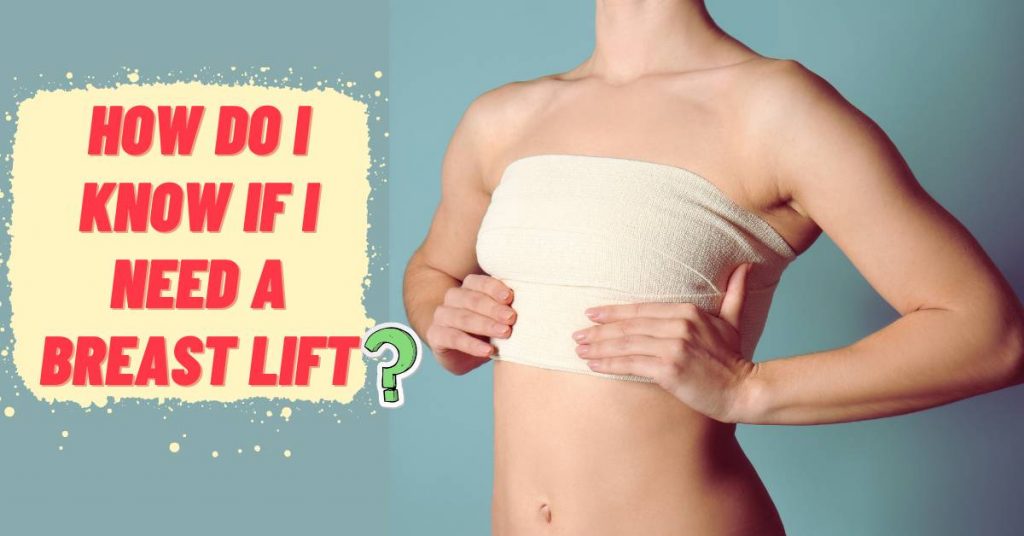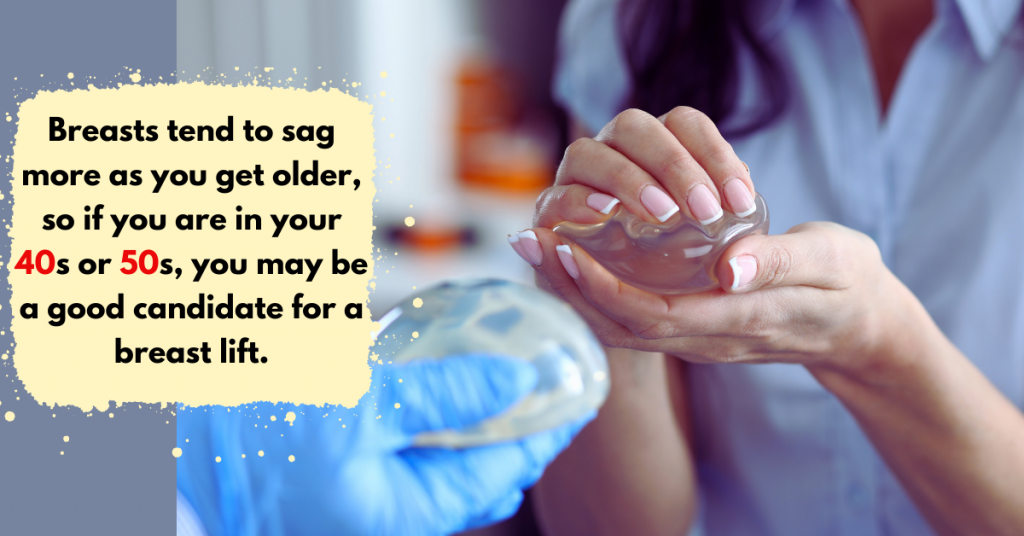How Do I Know If I Need a Breast Lift? Signs and Considerations

"How Do I Know If I Need a Breast Lift? If you're experiencing sagging or drooping breasts, a loss of breast volume, or changes in nipple position and areola size, it might be time to consider a breast lift. These signs often result from factors like aging, pregnancy, or weight fluctuations. Additionally, if you find that your breasts lack firmness and have an overall deflated appearance, a breast lift could help restore a more youthful contour. To determine if a breast lift is right for you, consult with a qualified plastic surgeon who can assess your individual needs and goals."
If you've been wondering about the possibility of getting a breast lift, you're not alone. Many individuals contemplate this procedure as a way to enhance their appearance and boost their confidence. But how do you know if a breast lift is the right choice for you?
In this article, we'll dive into the signs, considerations, and factors to help you determine whether a breast lift is the next step on your journey to feeling your best.
A breast lift, also known as mastopexy, is a surgical procedure designed to raise and reshape sagging breasts, restoring their youthful appearance. It's a decision that requires careful consideration, and understanding whether you need a breast lift involves recognizing specific signs and evaluating various factors.
Let's dive into the question of 'How Do I Know If I Need a Breast Lift?'
- Understanding Breast Lifts
- Signs That Indicate You Might Need a Breast Lift
- Considering a Breast Lift: Factors to Think About
- Consultation with a Plastic Surgeon
- Benefits of a Breast Lift
- Breast Lift Procedure: What to Expect
- Alternatives to a Breast Lift
- Real-Life Experiences: Patient Testimonials
- Cost Considerations and Financing Options
- Choosing a Skilled and Qualified Plastic Surgeon
- Risks and Complications
- Final Thought
- FAQs about How Do I Know If I Need a Breast Lift?
Understanding Breast Lifts
A breast lift involves removing excess skin and tightening the surrounding tissue to reshape and support the new breast contour. This procedure can also reposition the nipple and areola to a more youthful height. While a breast lift can provide remarkable results, it's essential to determine if it's the right choice for you.

Signs That Indicate You Might Need a Breast Lift
Sagging and Drooping Breasts
One of the primary indicators that you might need a breast lift is sagging or drooping breasts. Factors such as aging, pregnancy, breastfeeding, and weight fluctuations can lead to a loss of skin elasticity, causing the breasts to lose their firmness and position.
Loss of Breast Volume
Another sign is the loss of breast volume. If you've noticed that your breasts appear deflated or less full than before, a breast lift could help restore a more youthful and voluminous appearance.
Nipple Position and Areola Changes
Changes in nipple position and areola size can also point toward the need for a breast lift. If your nipples have started to point downward or your areolas have stretched, a lift can reposition them for a more balanced and aesthetically pleasing look.
Considering a Breast Lift: Factors to Think About
Before making a decision, several factors warrant careful consideration.
Overall Health and Lifestyle
Your overall health and lifestyle play a significant role in determining your candidacy for a breast lift. Being in good physical health and having realistic expectations are crucial.
Personal Goals and Expectations
Understanding your personal goals and expectations is essential. A breast lift can improve your breast contours and self-confidence, but it's essential to have a clear vision of the outcomes you desire.
Surgical Candidacy
During a consultation with a plastic surgeon, your suitability for the procedure will be assessed. Factors such as skin elasticity, breast shape, and nipple position will be evaluated to determine if a breast lift is right for you.
Here are some additional things to consider when deciding if you need a breast lift:
- Your age: Breasts tend to sag more as you get older, so if you are in your 40s or 50s, you may be a good candidate for a breast lift.
- Your lifestyle: If you are active and participate in sports or other physical activities, a breast lift may be a good option for you. A breast lift can help to improve your posture and reduce the risk of injuries.
- Your budget: Breast lifts can be expensive, so it is important to factor in the cost of the surgery when making your decision.
If you are considering a breast lift, it is important to do your research and choose a qualified surgeon who has experience with this type of surgery. With careful planning and execution, you can achieve the results you desire and improve your quality of life.
Consultation with a Plastic Surgeon
Scheduling a consultation with a skilled plastic surgeon is a crucial step in your decision-making process. The surgeon will discuss your goals, evaluate your breasts, and recommend the most suitable approach to achieve your desired results.
Benefits of a Breast Lift
Improved Breast Contours
A breast lift can restore youthful contours by lifting and reshaping the breasts. This procedure can provide a more youthful and uplifted appearance.
Enhanced Self-Confidence
Feeling confident in your body can have a positive impact on your overall well-being. A breast lift can help boost your self-esteem and enhance your body image.
Clothing Options and Comfort
Many individuals find that a breast lift allows for a wider range of clothing options and improved comfort. Clothes may fit better, and you might feel more at ease in various outfits.
Breast Lift Procedure: What to Expect
Preoperative Preparation
Before the procedure, you'll have a comprehensive discussion with your surgeon. You'll receive instructions on how to prepare, including guidelines for eating, drinking, and medication.
Surgical Techniques
During the procedure, incisions will be made to remove excess skin and reshape the breast tissue. The nipple and areola may be repositioned. The incisions will then be closed, and you'll be taken to a recovery area.
Recovery and Aftercare
Recovery from a breast lift typically involves some discomfort and swelling. You'll need to follow your surgeon's postoperative instructions carefully and attend follow-up appointments.
Alternatives to a Breast Lift
In some cases, alternatives to a breast lift may be more suitable. These alternatives might include nonsurgical treatments or combining a breast lift with other procedures, such as breast augmentation or reduction.
Combining Procedures: Breast Lift and Augmentation or Reduction
Combining a breast lift with augmentation (implants) or reduction (tissue removal) is a common approach. This combination can address multiple concerns and provide comprehensive results.
Real-Life Experiences: Patient Testimonials
Many individuals who have undergone breast lifts have shared their experiences and outcomes. Reading patient testimonials can offer valuable insights and help you understand the potential benefits.
Cost Considerations and Financing Options
The cost of a breast lift can vary based on factors such as geographic location and surgeon expertise. It's important to discuss the cost during your consultation and explore financing options if needed.
Choosing a Skilled and Qualified Plastic Surgeon
Selecting a skilled and qualified plastic surgeon is paramount. Research potential surgeons, review before-and-after photos, and read patient reviews to make an informed decision.
Risks and Complications
As with any surgical procedure, a breast lift carries some risks and potential complications.
Scarring
While efforts are made to minimize scarring, some degree of scarring is inevitable. However, scars typically fade over time and can be concealed under clothing.
Changes in Sensation
Temporary changes in nipple or breast sensation are common after a breast lift. Sensation usually returns to normal within a few months.
Infection and Bleeding
Infection and bleeding are rare but potential risks. Following postoperative care instructions can help minimize these risks.
Final Thought
Deciding whether you need a breast lift is a personal journey that requires careful consideration of your goals, needs, and expectations. By understanding the signs, exploring the benefits, and consulting with a qualified plastic surgeon, you can make an informed decision that aligns with your desires for a more confident and rejuvenated appearance.
FAQs about How Do I Know If I Need a Breast Lift?
How long does the recovery process typically last after a breast lift?
Recovery times can vary, but most individuals can return to light activities within a week and resume normal activities within a few weeks.
Will a breast lift significantly change the size of my breasts?
A breast lift primarily focuses on reshaping and repositioning the breasts, but it may not significantly alter their size. If desired, a combination of procedures can be discussed with your surgeon.
Are there any age restrictions for getting a breast lift?
There's no specific age restriction, but it's essential to be in good overall health and have realistic expectations.
Can I breastfeed after a breast lift?
While some women can still breastfeed after a breast lift, there may be a risk of reduced milk production. Discuss your plans with your surgeon during your consultation.
How long do the results of a breast lift typically last?
The results of a breast lift are long-lasting, but factors such as aging, gravity, and lifestyle choices can affect how long the results remain optimal.
I hope this article will clear and answer your question of 'How Do I Know If I Need a Breast Lift?'

Recommendation